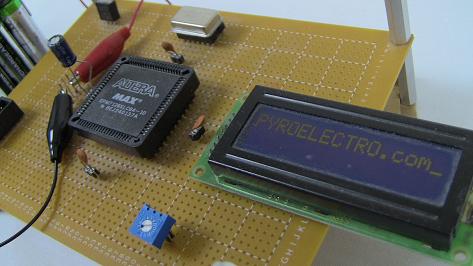An Overview Of The CPLD 16x2 LCD Interface
The CPLD module/interface presented in this article is about as simple as it gets, but it works and is easy to look through and understand. A basic state machine was used and through each state, it is clear how and what state changes occur on the modules data and control pin outputs. Commands were sent to setup the LCD and then characters were sent to write output to the display.

What To Do Now
Like I mentioned before, Altera has a very wide selection of pre-made drop-in modules in the QSYS library and the 16x2 LCD module interface is once of them. It's free, so go take a look and try adding it to your design and getting it to work as it will have far more advanced functiality and probably a better quality of code to it. After-all I do my projects in a week, and Altera is a CPLD/FPGA manufacturer, so no doubt their module has been trimmed and perfected over time. Another good experiment to take a look at would be to convert this module to use the 4-bit mode that the HD44780 LCD interface offers.
Conclusion
Another quick, easy and successful project done! This article was not meant to be extremely difficult, but to show you the basics for how you can get started telling a 16x2 LCD what to output by sending it control commands and output display commands. Since FPGAs and CPLDs are modular you'll be able to re-use the VHDL module presented in this article, but hopefully you will take a look at Altera's QSYS library and see if what they have better suits your needs.
If you have any further questions, I implore you...don't be shy, take a look at the forums or ask a question there. I check them out regularly and love getting comments & questions.
The CPLD module/interface presented in this article is about as simple as it gets, but it works and is easy to look through and understand. A basic state machine was used and through each state, it is clear how and what state changes occur on the modules data and control pin outputs. Commands were sent to setup the LCD and then characters were sent to write output to the display.

What To Do Now
Like I mentioned before, Altera has a very wide selection of pre-made drop-in modules in the QSYS library and the 16x2 LCD module interface is once of them. It's free, so go take a look and try adding it to your design and getting it to work as it will have far more advanced functiality and probably a better quality of code to it. After-all I do my projects in a week, and Altera is a CPLD/FPGA manufacturer, so no doubt their module has been trimmed and perfected over time. Another good experiment to take a look at would be to convert this module to use the 4-bit mode that the HD44780 LCD interface offers.
Conclusion
Another quick, easy and successful project done! This article was not meant to be extremely difficult, but to show you the basics for how you can get started telling a 16x2 LCD what to output by sending it control commands and output display commands. Since FPGAs and CPLDs are modular you'll be able to re-use the VHDL module presented in this article, but hopefully you will take a look at Altera's QSYS library and see if what they have better suits your needs.
If you have any further questions, I implore you...don't be shy, take a look at the forums or ask a question there. I check them out regularly and love getting comments & questions.